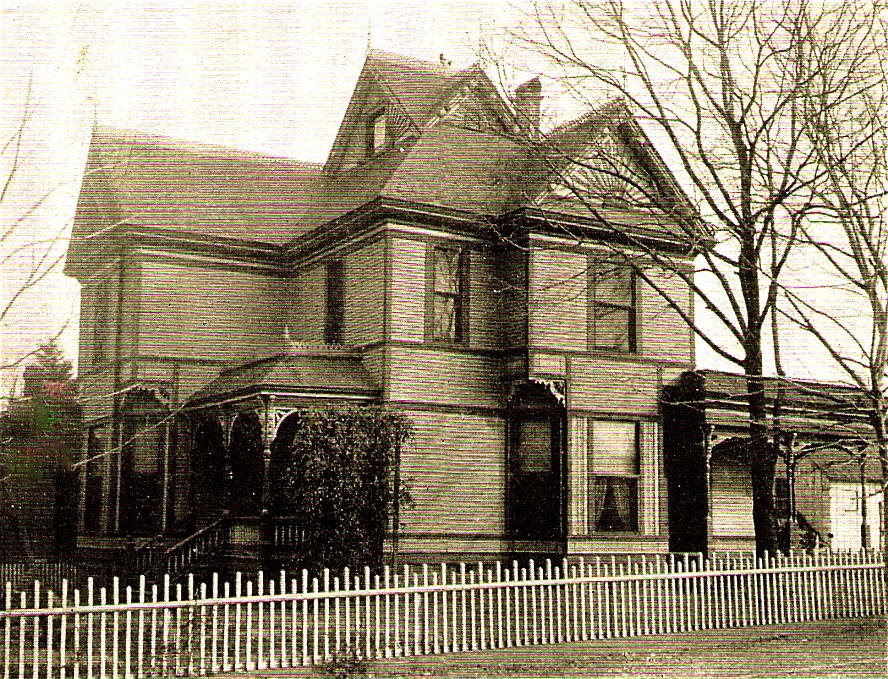|
George R. Gumpert Sr., MKT Engineer (1860–1921) George
R. Gumpert was a longtime
conductor and fireman on the MK&T Railroad, based in Denison,
Texas. He was
born in By
1887, George and his brother Pearl Gumpert (1863–1911) had moved to
Denison and were both working as train engineers on the Katy. Initially
George
and Rachel lived at 722 West Day Street, but they soon moved west to
the corner
"Residence
of George Gumpert." Over the years, George experienced
numerous losses and traumas. In August 1903, he was badly injured in a
head-on
George died a year later, on April 28, 1921, and was buried in Denison's Fairview Cemetery. Rachel lived on in their house until her death on July 7, 1941.
Four
Are Injured [Source: Dallas
Morning News, August 10, 1903] With
Terrific Crash Katy Passenger Trains
Collide Near Trinity River. Rescue of Engineer Maimed Man Is Pulled
from the Blazing Cab to the Roof of a Car. Wreck
on Embankment The Scene of Accident
Is at a Sharp Curve Leading Up to Long Bridge. Two Katy passenger trains collided, head on, last night shortly after 8 o'clock at a sharp curve on the high embankment which leads to the bridge across the Trinity River, about two miles south of the city. Four persons were
injured — two of them seriously — passengers in both
trains were thrown to the floor and hurled over seats, the engines were
considerably damaged, and in nearly every car panes of heavy plate
glass were
shattered to atoms. The injured: George Gumpert, engineer on No. 34, northbound,
both legs broken. James Alders, engineer on No. 5, southbound,
collarbone fractured. Ike Smith, colored, porter on No. 34, leg broken,
severe cut on head and believed to have sustained internal injuries. Harry Thompson, colored, of Corsicana, passenger on
No. 5, head cut. The train seems to
have been moving at a pretty rapid rate. Railroad
Commissioner Allison Mayfield, who, with his wife, occupied the rear
seat of
the last sleeper on No. 5, which was the southbound Flyer, estimates
the speed
of that train, which was just beginning to get under good headway after
leaving
Dallas, at not less than twenty-five and possibly thirty miles per hour. "All of we passengers
were badly shaken up," he said,
"but no one was hurt on our train." When the trains
stopped, the northbound engine was on the trestle of the
bridge, the front tracks resting on the embankment. It was firmly
welded into
the one which pulled the Flyer, and the front work of both, including
the cabs,
was torn and twisted. The rescue of Engineer
Gumpert was thrilling. Pinned down in his cab,
with the woodwork around him blazing fiercely, it required the service
of a
score of men with axes and fully two score more, who formed a bucket
brigade,
to drag him from his perilous position. As it was impossible to lower
him to
the ground from the trestle, he was placed on top of the baggage car,
and there
he was forced to lay for about four hours. Smith, the porter,
jumped from the train just before the collision, and
is said to have been picked up in an unconscious condition from among
the
brambles on the banks of the river many feet below. It is stated by the
trainmen of [omission?] that the Katy Flyer left
Dallas on time with instructions to stop at the siding at Honey
Springs, which
is just beyond the river, and await there the arrival of No. 34. No. 5
was due
at Honey Springs at It would be difficult to find a
worse place for a wreck. The embankment
is between forty to fifty feet high. The road curves just before
crossing the
river and rises with each foot. The short
trestlework which connects the
embankment and the bridge is many feet above the ground, which, in many
places,
is covered with heavy stone for ballast. When the trains came
together, the crash was heard all over Colonial
Hill, some persons who live nearly a mile from the scene informing a
representative of The News that
they
were drawn to the place by the sound of the clash. The forward trucks
of each
engine left the rails. The first news of the
wreck reached this city about twenty minutes after
it occurred. The tidings spread with rapidity of fire in a powder
magazine.
Hundreds at once started for the scene, using every possible means of
conveyance. It was said that many persons were killed. The first call
was for
six physicians and an ambulance. Ten minutes later, word came to send
all the
physicians who could be found. About an hour after
the wreck, the coaches of the Flyer were brought
back to Dallas by a switch engine. Minus the baggage car, which was
left at the
location of the accident; it was sent over to Fort Worth via the Texas
and
Pacific about 11 o'clock, and from that place went south over the
Missouri,
Kansas and Texas tracks. W. R. Ellis, Dallas;
G. A. Gray, Belton; R. L. White, Lancaster; B. W.
Owens, Fort Worth; and W. H. Alkire of Dallas, all passengers on the
northbound
Katy train which collided with the Flyer last night, reached Oak Cliff
in a
wagon soon afterward, and took the Oak Cliff cars for Dallas. Mr. Gray stated that
the conductor on his train was very prompt, and as
soon as he saw that the train had passed the switch, he rang the bell
and
applied the emergency brake. Mr. Ellis had in his possession a piece of plate glass five-eighths of inch thick which he stated was broken by having the negro porter thrown against it. "No, the porter is uninjured," he said. Police Sergeant George
Smith returned at midnight from the scene of the
wreck. He says that Engineer Gumpert was lowered into the baggage car
of the
northbound train through a hole cut in the roof. An examination by
physicians
led to the discovery that Mr. Gumpert is badly crushed. It was not
believed
that he could live an hour or that it would be possible to bring him to
Dallas
in an ambulance, which was near the car.
Fatalities Not Likely Believed
That All Injured in the Katy Head End
Collision Will Recover. [Source: Dallas
Morning News, August 11, 1903] It is now believed
that no fatality will result from the head-end
collision on passenger trains near the city on Sunday night. From St.
Paul's
Sanitarium it was reported last night that George Gumpert, the engineer
of the
northbound train, was not injured as severely as it was at first
feared. He
seems to have sustained a fracture of three ribs on the left side, but
it is
thought that no other bones were broken. There was no cut or abraded
skin, and
it was said that there seemed to be no internal trouble. He is resting
well. James Alders, the
engineer on the train going south, left for his home
in Denison. He had received a partial fracture of the left collarbone,
but
seems to have escaped further injury. Ike Smith, the negro
porter on the northbound train, was said to have
sustained a fracture of both legs above the knees, a painful wound in
the fore
part of the head, and many bruises. It was thought that he might be
taken to
the railroad hospital in Missouri. Harry Thompson,
colored, a passenger on his way south, was able to leave
for his home in Corsicana. Thomas J. O'Connor, roadmaster of
the Katy, was a passenger on the
southbound train. He says: "If the train going south had been one
second
earlier the trains would have met in the middle of the bridge and the
result
might have been awful. As it was, they came together on the end of the
structure, so that there was no falling of the wrecks. I examined the
engines
after the collision and found that both engineers had set the reverse
levers
and had on a full head of steam. They had done all they could."
Funeral
of Engineer Reece. [Source: Dallas
Morning News, May 28, 1907] Special
to the News. Denison, Tex., May 27.
— Dave T. Reece, the Katy engineer who was killed
by being hit with a mail crane last Saturday at Chambers, I. T. [Indian
Territory], was buried from St. Joseph's Catholic Church at 2:30 this
afternoon, Rev. Father Hutcheson officiating. The popularity of the
dead
engineer was amply attested by the large cortege that followed the
remains to
Fairview Cemetery. The following brother engineers acted as
pallbearers: George
Gumpert, Henry Royce, [Note: A mail crane was an
approximately 10-foot tall metal standard
along a railroad track that was used to exchange mail between small
town post
offices and railway post offices (RPOs). As the train approached, an
RPO clerk
on the train prepared the catcher arm, which would then snatch the
incoming
mail pouch in the blink of an eye. The iron arms of the crane would pop
open,
releasing the pouch to the RPO car. At the same time, the clerk kicked
the
outgoing pouch out of the car. The special catcher pouches used in the
service
had metal rings at each end to attach to mail cranes. — Information
obtained
from the National Postal Museum.]
Katy
Flier Derailed Northbound
Train Leaves Track at Aubrey, but
Remains Upright. [Source: Dallas
Morning News, October 17, 1913] Special to the News Denton, Tex., Oct. 16.
-- The northbound Katy Flyer was derailed three
miles north of Aubrey this forenoon, all of the cars leaving the track,
but
remaining upright. The engine remained on the track. Traffic over the
joint
track was canceled today, as several hundred feet of track was torn up.
It will
be late tonight before trains can be run. First accounts received here
were
that nobody was hurt, but it was reported later in the afternoon that
one woman
was bruised. Relief
Train from Dallas. The relief train which
was sent out from Dallas yesterday morning to
bring back passengers and mail from the northbound Katy Flyer, which
was
derailed four miles out of Pilot Point on the Fort Worth branch
returned to
Dallas at 9:50 o'clock last night. So far as could be learned no one
was hurt,
further than receiving a severe shock. The cars all left the
track, but the engine remained on the rails with
all couplings holding. The train was in charge of
Conductor Farnsworth, with Engineer George
Gumpert and Fireman Burgett on engine No. 269.
Engineer
on Katy Hurt When Train Hits Open
Switch [Source: Fort Worth
Star-Telegram, August 3, 1917] Engineer George Gumpert of Denison on Katy passenger train No. 26 out of Waco, suffered a severely wrenched back Friday about 8:30 a.m. when his train hit an open switch in the local Katy yards and collided with a string of box cars on a siding. Three of the cars were piled up on the right of way. Gumpert was taken to his home in
Denison.
 Biography Index German Heritage Research Susan Hawkins © 2024 If you find any of Grayson CountyTXGenWeb links inoperable, please send me a message. |

